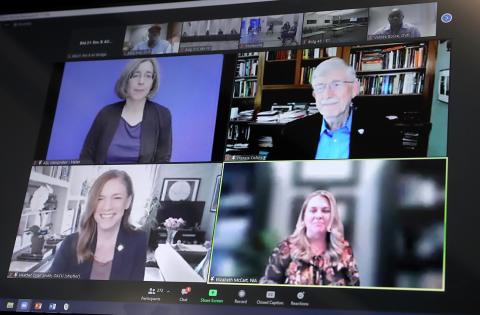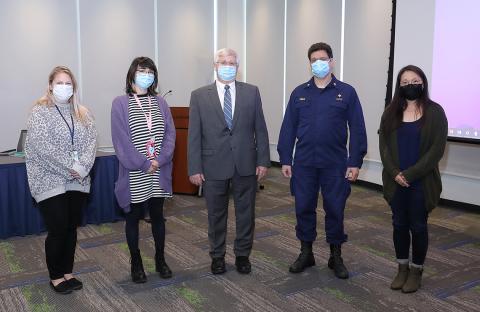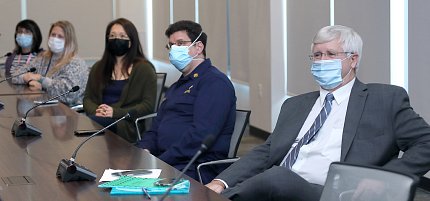‘Heart and Soul’
Animal Care Workers Appreciated on Director’s ‘Gratitude Tour’ Call

Photo: Chia-Chi Charlie Chang
“Animal care workers make the NIH mission possible,” NIH director Dr. Francis Collins told attendees at a recent “Gratitude Tour” stop.
The director continued making his rounds to thank groups and individuals for their dedicated work over the last nearly 2 years under pandemic conditions. He recently visited virtually with animal care workers in a call introduced by Dr. Stephen Denny, director of the NIH Office of Animal Care and Use.
Animal-based research has a long history of providing fundamental insights that lead to significant medical advances—the most recent being Covid-19 vaccines and treatments. The Oct. 14 tour stop was originally intended to be in-person, but Covid-19 prevented that. However, there was a silver lining: the virtual format allowed animal care workers (ACWs) from across the country to join the call. Staff from Bethesda, Rockville, Frederick, Poolesville and Baltimore, Md.; Research Triangle Park, N.C.; Hamilton, Mont.; and Holloman Air Force Base, N. Mex., were able to attend.
Twenty-five NIH institutes use animals in their intramural science programs, and there are currently more than 2.3 million animals advancing NIH intramural research annually, according to Denny and OACU. “We hold approximately 1.5 million animals daily in our research colonies,” he noted. Their care is diligently managed by more than 1,000 veterinarians, cage washers, technicians, administrators and others, and these employees have upheld a high standard of care throughout the pandemic.
Many examples of exceptional dedication of animal care workers were cited. The NIH Division of Veterinary Resources implemented a lab animal adoption program in February 2019 and has re-homed more than 40 animals (including rabbits, guinea pigs, minipigs, sheep and dogs). In June 2021, the Bethesda animal research sites also successfully underwent the intensive triennial AAALAC International accreditation site visit. AAALAC is a private, nonprofit organization that promotes the humane treatment of animals in science through voluntary accreditation and assessment programs.

Photo: Chia-Chi Charlie Chang
Deputy director for intramural research Dr. Michael Gottesman shared during the Zoom that he had just received the email confirming NIH’s continued, full accreditation status for the next 3 years, documenting the agency’s commitment to responsible animal research practices.
Collins gave a shout-out to the animal technician in his own NHGRI lab, Urraca Tavarez, who rises early every morning to take care of the mice that are vital to research on Hutchinson-Guilford progeria syndrome. “Urraca is a really critical part of our team,” Collins said.
Because of the nature of their jobs, many ACWs could not telework. They had to contend with distancing requirements, isolation from coworkers, difficulties in using public transit and many other complications. There were also upsides, though, as revealed by representatives from across the country.
Liz McCart, an NIA program specialist in Baltimore, spoke about the challenges of being a new employee at the start of the pandemic.
“I had only been at my job for 4 months when we switched to maximum telework,” she said. “It was challenging to figure out a new animal care facility while many employees were teleworking.” She was not the only new NIA employee at this time: they also onboarded a new animal program director.
“As you can imagine, it was the blind leading the blind for several months when it came to remembering names, room numbers and locations of things,” McCart said via email. All soon found their way, though. McCart settled into her position and became the go-to person for coordinating lab access for investigators.
Johnny R. Green, a training specialist contractor working at NIEHS, described Covid-19 as “a rugged mountain we’ve been navigating,” but “we’re all in this together.” He said he and coworkers have learned to tap into “our versatility to adapt to the unpredictable nature of Covid-19” in response to pandemic-related staff shortages. Green and colleagues pulled together to take care of the animals, investigators and each other.

Photo: Chia-Chi Charlie Chang
Valdez Bosse, an animal care specialist who has worked at NIH for 17 years works for the Division of Veterinary Resources. Since the start of the pandemic, he has learned how to care for an entirely new species of rodents (shrews) and has become the shrew expert among his coworkers. He has also taken on supervisory responsibilities and dealt with the challenges of working split shifts with fewer employees.
“It was tough not seeing some of the coworkers that I’ve been used to working with for the past 17 years,” he admitted, but he was also grateful for his new supervisory role and the new experiences caring for a different kind of rodent.
“The tamer of the shrews!” Collins joked.
Lydia Crawford, a biosafety level 4 husbandry technician at NIAID’s Rocky Mountain Laboratories, spoke about the spirit of community that arose from what could have been a disruptive lab shutdown. Procedures occur yearly for equipment and system repairs, she said, but pandemic restrictions added a new layer of complexity.
Several of the busiest entrances to a BSL-4 lab were shut down, but rather than creating tension by reducing the number of exits, it created new opportunities for interaction. Crawford spoke fondly of investigators helping animal techs carry bags of feed and bedding into the lab. “No one will look at lab shutdowns the same after this year,” she predicted.
“RML did some of the most important animal work in the world as Covid-19 was coming forward,” Collins informed the audience. “You [all] should feel really good about the contributions you made to our understanding [of] this virus.”
Kelly Key spoke about the difficulties of getting to work using public transit in the early days of the pandemic. He is an animal caretaker with DVR in Bethesda and is another 17-year NIH veteran.
The local buses and trains that Key relied on to get to work were often delayed or shut down, and he used Uber or Lyft on the weekends when the trains and buses didn’t run early enough. He also worked 12-hour split shifts. One positive aspect, Key said, was getting to work more closely with his supervisor, which helped Key take on more supervisory duties himself.
Like Crawford, Key also played a role in taking care of animals that were essential to Covid-19 vaccine development, which he said was a “very satisfying accomplishment with a worldwide impact.”
“You all should feel really good about NIH’s role,” Collins agreed.
Workers also prioritized the protection of vulnerable animals. The chimpanzees remaining at the Alamogordo Primate Facility are former research animals and are all immunocompromised, and chimpanzees in general are susceptible to upper respiratory infections brought on by the human cold and flu season. Veterinarian Lon Lammey and his colleagues made the decision to halt all tours of the facility and adopt split shifts to minimize the number of employees onsite.
“We stopped having respiratory outbreaks after about 8 months of limited access,” Lammey revealed.
The animal techs “really stepped up,” he said. “They are the heart and soul of what we do here and they made sure the animals got the quality of care they deserved.”
To close the call, Collins commended ACWs for their unceasing commitment to the animals.
“You have made NIH’s mission possible by what you do,” he said. “We’re the National Institutes of Health—and the National Institutes of Hope—and you’re part of that hope.”
